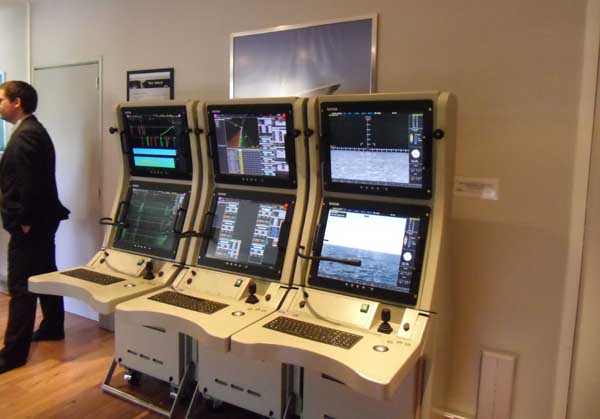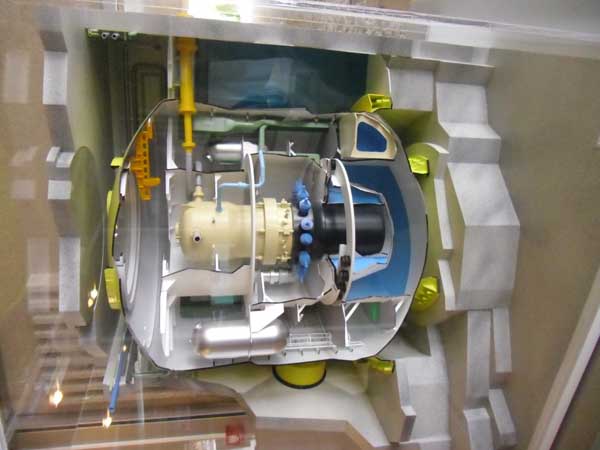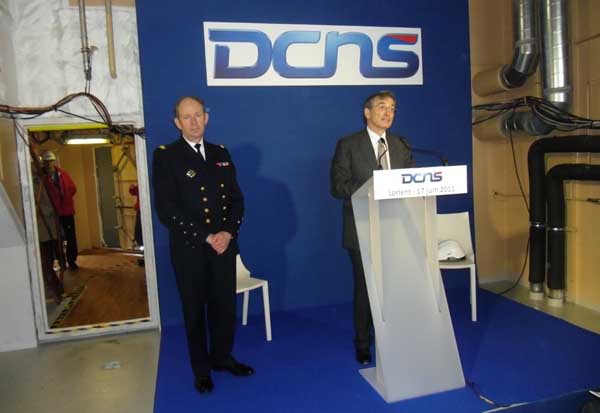|
DCNS has entered the energy field as well and
is fast becoming an innovative player in that
sector.
In mid June this year, DCNS invited selected
world media attending the Paris Air Show to visit
its yards at Nantes and Lorient in Brittany, north-western
France, and also to witness the naming ceremony
of its latest innovative 1,500 ton Gowind Off
Shore Patrol Vessel (OPV) L’Adroit. The ceremony
was to be performed by France’s Finance Minister
Christine Lagarde, (now Chief of the International
Monetary Fund), in the presence of Admiral Pierre-François
Forissier, Chef d'Etat-Major de la Marine Nationale
(French Navy’s Chief of Staff) on 17th June.
VIPs from Paris and Naval Attaches were also invited
and a display of equipment supplied to the ship,
including the onboard Austrian small UAV Schiebel.
(This UAV is also being considered for purchase
by the Indian Coast Guard).
As it turned out M/S Lagarde could not attend.
An emergency, the Greece bail out finance meeting
got scheduled for the same day, and the Godmother
of the L’Adroit, Isabelle Le Ny who has worked
in DCNS for 17 years and was involved in the ship’s
construction, named the ship in a ‘Champagne
breaking ceremony’ in light rain, considered
a good omen. Media from India was in attendance
including India Strategic.
DCNS said that it built the Gowind vessel with
its own funds, and would lease it to the French
Navy for three years for sea trials. After that,
vessels of this new design and class would be
sold, including to India if the latter is interested.The
history of the DCN yards, as it was known before,
dates back to 1631 when Cardinal Richelieu set
up France’s first significant naval shipyard
and set in motion France’s rise as a maritime
and colonial power. Many shipbuilding yards mushroomed
in France; in Ruelle (1751), Nantes-Indret (1771)
where the Air Independent Propulsion (AIP) MESMA
for submarines is manufactured, Lorient (1778)
and subsequently in Cherbourg (1813). In 1858
the world’s first iron-clad, steam powered
battleship La Gloire was laid down, and by then
the Government had taken over and consolidated
various military shipyards.

During the second world war, the French Ministry
of Defence had its warships and submarines designed
and built by DCN and later incorporated the group
into the military procurement agency Délégation
générale pour l'armement (DGA).
In 1997, the French government decided to reform
its shipbuilding and procurement system for naval
ships. Design and procurement were separated from
production and DCN retained the industrial part,
but in 2000 DCN was transformed into a national
service, like India’s state-run Public Sector
Undertakings (PSUs), under the direct responsibility
of the Minister of Defence; and no longer under
DGA.
In 2001 with the wave of globalization sweeping
the world, the French government announced plans
to transform DCN into a private company, and adopted
the brand name DCNS, now with annual revenues
of $ 3 bill. There are lessons for India in this
history of France’s warship shipbuilding
industry, as India is aspiring to become a maritime
power, befitting its size.
THE DCNS WARSHIP AND SUBMARINE
CONSTRUCTION FACILITIES
The visit to DCNS shipyards at Nantes and Lorient
and the large infrastructure showcased most of
the company’s capabilities, jigs, fixtures,
shaft lines and thrust blocks construction facilities
and automation needed for construction of the
hull from steel plates by computer controlled
automatic steel cutting machines.
Large plate bending machines apply curvatures
and then the ready pieces are welded to form modular
sections of warships or submarines up to 300 tons
in various areas and then outfitted, to be transported
even long distances for joining the sections,
termed Integrating Hull Outfitting and Painting
Procedure (IHOP).
Notably, Indian shipyards are now adopting this
modular building technique, which was first used
to build sections of India’s first nuclear
submarine INS Arihant by Larsen and Toubro Ltd
at its facility at Hazira and at Submarine Building
Center at Vishakapatnam.
In the case of large ships being built by DCNS
like the 7,200 ton latest FREMM guided missile
frigate under construction at Lorient, the sections
were seen to be joined in a large dry dock, where
the India media was given a conducted tour.
In the case of the smaller OPV type ships and
submarines the joining of sections is executed
on platforms with large over head gantry cranes.
It was evident that construction of submarines
is just like warships, except that the space inside
the submarine is at a premium, thus increasing
the complexity, both in terms of accessibility
and handling of equipment and systems which require
precision.

The quality control methods and pre-launch trials
and the matured processes for training and developing
the workforce, data and project management and
aspects of information security, were explained,
and a visit to the ship model testing tank that
is available next door to the shipyard in the
SIREHNA facility of Nantes University.
Visitors were shown live trials in progress.
Indian shipyards have used MARIN of Netherlands
for tank testing of its designs as it also has
a vacuum facility for testing. An indoor ‘testing
tank’ has been set up at Naval Science and
Technological Laboratory (NSTL) at Vishakapatnam.
What evinced keen interest by visitors was the
manufacturing of the ‘Pressure Hull’
of the submarines which is the single most distinct
feature which differentiates the submarine from
a warship and requires specialized HY-100 type
steel and precision welding as it separates the
crew from high water pressure of water hundreds
of meters below the surface of the sea.
Pressure hull fabrication therefore needs highly
skilled technicians and experienced welding engineers
who have years of experience.
DCNS, which has the ongoing contract to build
six Scorpene submarines for the Indian Navy, has
already trained personnel at Mazagon Docks Ltd
(MDL) in this technique. Not an iota of distortion
is permitted and testing is mandatory for each
of the specialized welding processes called ‘
flux shielded arc welding’(SMAW) for sub-assemblies
of different curvatures. The submarine sections
are joined together to ring frames to form the
submarine hull for launching.
AIP, the Cheap Alternative
To Nuclear Propulsion
Modern conventional submarines the world over
are now being fitted with air independent propulsion
(AIP) modules to enable submarines to propel distances
without surfacing for days like nuclear submarines
do, and the French DCNS have perfected the MESMA
steam system which can also be retro-fitted in
hulls.
The Indian Navy is scouting for AIPs for its
older submarines while DCNS has offered to install
this system in the last two of the six Scorpenes.
Discussions are on in this regard.
DCNS displayed how the system works in a prototype
facility. Compressed oxygen gas at minus 180 degrees
is made to combust with ethanol in a turbocharged
compartment to generate heat for steam. MESMA
modules are outfitted and welded in a vacuum cylindrical
machine.
In fact, DCNS displayed a system – possibly
the second of the three Mesma ordered by the Pakistan
Navy for its DCNS-designed Agosta 90B submarines.
MESMA is a 160 ton 8.7 metre-long ‘plug’
inserted into the boat’s after hull.
Pakistani submarines are under a major refit,
and the module displayed was to be transported
to Pakistan to be installed with DCNS technical
assistance for one of the two Agosta 90Bs (PNS
Khalid or PNS Saad) in active service.
The first Mesma module was integrated directly
during the construction of third-of-class Agosta
90B submarine PNS Hamza which entered active service
in 2008.
Following the ‘cut-and-plug’ method,
the refitted Agosta boats would then have a length
of 76.2 metres for a submerged displacement of
1980 tonnes.

The Mesma module produces steam to run a small
turbine to charge batteries internally, without
surfacing and enables submarines to remain submerged
for about three weeks at a time.
Before dispatch, Mesma is tested at DCNS’s
Indret centre. This is done to ensure that the
module works as designed and meets its performance
specifications. More specifically, DCNS engineers
and technicians check the AIP’s output power,
endurance and range. These tests are followed
by acceptance tests in the presence of customer
representatives.
“We have the benefit of some economies of
scale,” explained Delphine Bréhéret,
the Mesma programme manager at DCNS’s Nantes-Indret
centre. “The first module (to Pakistan) was
delivered in June 2002. Knowledge sharing and
lessons learned have played an important part.
We have now started testing module number three.
This time, the test teams will include Pakistan
Navy engineers.”
Nuclear Submarine Construction
While witnessing the construction of ancillary
systems at Nantes and Lorient for the six Barracuda
class SSN nuclear submarines ordered by the French
Navy (photography was not permitted), it was explained
that outfitting of any nuclear submarine is akin
to that of any other conventional submarine.
The exception is that the ‘atomic pressure
water reactor (PWR)’ is inserted with its
core in to the hull as a sealed unit, as BARC
has done for INS Arihant.
The ship’s crew and rest of the submarine
are fully protected from the reactor.
The steam generated in the reactor is sent to
a heat exchanger/condenser for turbine propulsion
(like in all steam driven ships and power plants),
and for battery charging.
The outfitting environment for submarines therefore
requires design of special equipment and compact
machines for in-situ operations, and a 3-D digital
model serves to display a virtual replica of the
design for a worker to follow.
RFID and barcodes on the machinery pieces avoid
human errors, and line scanners and WiFi access
to the main server and designs is available to
supervisors.
A visit to the Submarine design center was also
facilitated where 40 Brazilian submariners, constructors
and engineers under Capt Mauro of the Brazilian
Navy are training to build four conventional submarines
and a nuclear submarine in Brazil in a long drawn
programme with DCNS help.
A visit to the SUBTICs command and control console
of the Scorpene submarines was arranged. The entire
missile and torpedo firing system and control
for periscopes and inertial navigation that is
supplied from SAGEM are married with radars, EW
systems and sonars from Thales with frequency
hopping communications.
This writer, as a former Navy navigator attempted
to operate the system, and found it fascinating,
not challenging if training is provided as it
is fully computer aided.
Two SUBTIC systems have also arrived at MDL for
fitment in the Indian Navy’s first two Scorpene
submarines, and a training simulator is being
contemplated.
DCNS’S EXPANDING
PRESENCE IN INDIA
In India, DCNS is currently engaged in the $
5 bill worth construction of six SSK Scorpene
submarines (Project 75) at Mazagon Docks (MDL)
in Mumbai under the transfer of technology (ToT)
route. DCNS India has also been working to select
and qualify Indian companies as partners for local
production of the Scorpenes’ components and
has tied up with Walchandnagar Industries Ltd
(WIL) for supplying critical components for its
local and international submarine projects and
for supplying the Raft Mounted Engine Platforms
(RMEP) for the four Type 28 Kamorta class ASW
Corvettes being built at GRSE Kolkatta.
This was revealed by DCNS Chairman Patrick Boissier
in 2010 while unveiling of Walchand’s "Vinod
Doshi Technology Center" set up by at Pune,
which employs many former naval officers.
Since the 1970s commencing with the ambitious
and very successful Leander project, WIL has been
a large supplier of plumber blocks and shaft lines
to the Indian naval ships. It also supplies nuclear
reactor components for India’s nuclear plants
and has contributed heavily to the 80 MW nuclear
reactor built by Bhabha Atomic Research Center
(BARC) for India’s first nuclear submarine
INS Arihant scheduled for sea trials off Vishakapatnam
later this year.
DCNS has also signed a contract with Flash Forge
India Pvt Ltd, based in Visakhapatnam, for collaboration
and manufacturing of mechanical equipment, and
to fulfil offset obligations. India’s follow
on two nuclear submarines are reported to have
different characteristics from INS Arihant and
are incorporating more modern imported and indigenous
technologies and systems, offered by DCNS.
DCNS has set up DCNS Private (India) Ltd in New
Delhi. At Mumbai, CEO Xavier Marchal oversees
activities with MDL and has Spain’s Navantia
Shipyard involved in engine room construction
activity, aft of section seven of the Scorpene
submarines. DCNS is also actively looking to bid
for the $ 7 billion follow on six Project 75-India
submarine RFP which is being formulated for issue
with AIP requirements.
DCNS is also eyeing other naval projects in
collaboration with Indian shipyards, like the
four Mistral type LPD project and the Coast Guard
OPVs projects approved by Defence Acquisition
Council (DAC).
Managing Director of DCNS (India) Bernard Buisson
has elaborated the role of the company, “We
are in India to establish partnerships with the
Indian industry to develop local capability and
to perform genuine transfers of technologies.
We are providing our Indian partners with knowhow
and technical assistance to manufacture equipments
which will be installed onboard the Scorpene submarines.
MDL, our main contractor, is also to sub-contract
work to these local players. Together, we are
qualifying the suitable companies which are meeting
the rigorous specifications needed for the submarines”.
Naming of OPV L’Adroit
and its Characteristics
During the visit of media to Lorient on 17th
June, 2011 the day turned out to be a red letter
day for DCNS with celebrations with champagne
for two distinct events. On that day in Lorient,
the ships Godmother Isabelle Le Ny in the presence
of Admiral Pierre-François Forissier and
Executive Vice President & Deputy Managing
Director of DCNS Bernard Huet, named the 87 meter
long Gowind offshore patrol vessel the L’Adroit.
The OPV has been built at DCNS’s cost for
maritime safety and security missions (MSS), to
prove many new innovations DCNS has adopted with
techniques of economy in ship building.
The ceremony was witnessed by about 500 VIPs,
naval attaches, potential customers, partners,
co-suppliers and employees of DCNS.

The L’Adroit programme spearheads DCNS’s
ambitious efforts to win a larger share of the
growing markets for small- and medium-displacement
surface ships which come under the umbrella OPVs.
By end-2011, L’Adroit will be transferred
over to the French Navy to operate and report.
Admiral Pierre-François stated that the
ship would be used for anti piracy operations
as it will be a cheaper option and the ship will
be as versatile as bigger platforms with a crew
of 35, and a UAV and a small helicopter on board.
The visitors were shown around the unique features
of the L’Adroit, the first member of the
Gowind family which was built in just 18 months,
with 50 partners.
The ship, combines advanced technologies of
radars and Electronic Warfare (EW) and carries
a Schiebel UAV which with a 25 kg payload of cameras
and radars. The ship has an aft ramp to launch
fast boats in minutes and a revolutionary single
enclosed mast which goes through the bridge and
enables 360° visibility for bridge crew and
sensors alike.
This trend is catching on in many navies. The
L’Adroit has three weeks blue-water endurance,
a range of 8,000 nautical miles, a top speed of
21 knots and a helicopter/UAV flight deck which
can land a 10 ton helicopter for fuelling and
transit, and a hangar to house a 5 ton machine.
The design also features full provision for comforts
of the complement and a dedicated space for 30
passengers, or even captured pirates?
Significantly, on that very same day at St.
Petersburg, Chairman DCNS Patrick Boissier, in
the presence of Russian President Dmitry Medvedev,
signed an agreement with Russia’s defence
export agency Rosoboronexport under the Franco-Russian
agreement for the supply of four 22,00 ton 199
metre long Mistral/LPD-type force projection command
vessels.
The initial contract covers two Mistral/BPC ships
and associated services, including initial logistics,
training, and the transfer of technologies.
DCNS will act as the prime contractor and will
also integrate the operations direction, command
and control and communication systems. The shipbuilding
of the first two Mistral platforms will be subcontracted
to the Japanese owned STX shipyard at Saint-Nazaire
in Western France assisted by Russian shipbuilder
OSK. The sale of these two vessels to Russia represents
more than 1,000 full-time jobs in France over
a period of four years. The first ship will be
delivered to Russia in 2014. The costs were not
disclosed.
The first two LPDs Mistral and Tonnerre, were
built by DCNS and then-Chantiers de l’Atlantique,
and delivered to the French Navy in 2006 and 2007
respectively. The third-of-type the Dixmude is
being built by DCNS and STX France, and is scheduled
for delivery to the French Navy in 2012.
The Indian Navy has interest in this class of
ships after experiencing the benefits the 19,000
ton LPD INS Jalashwa – formerly USS Trenton
which the Indian Navy virtually got for free –
has provided and has issued RFIs for 4 LPDs along
with 7 Type 17A frigates like the FREMM variety
and 6 Submarines to be built in India. Time has
been given to enable the shipbuilders to tie up
designs and collaboration with foreign and Indian
shipyards to assist in replying the final RFPs.
Most large foreign shipyard representatives including
DCNS have visited potential Indian shipyards.
The potential orders to be issued will be worth
more than $ 15 bill.
|